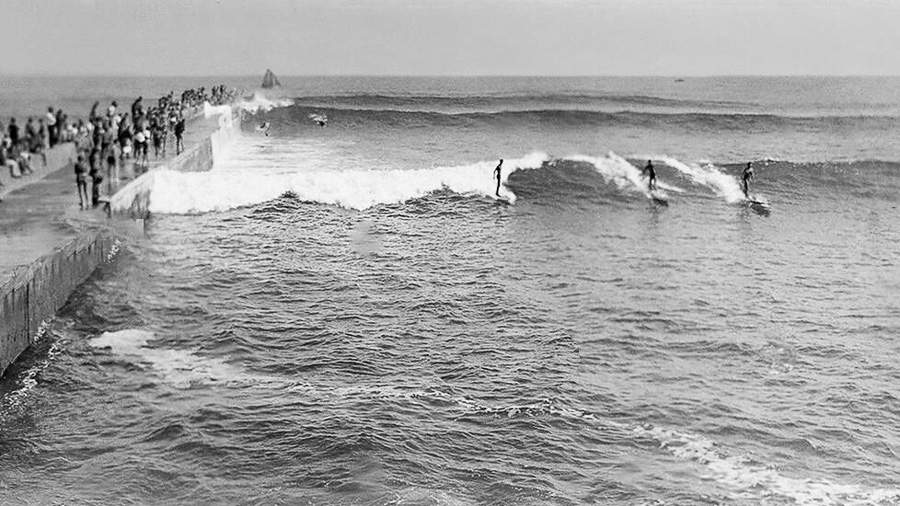“THE RIDERS OF THE FOAM-FLECKED SURF WILL BE SEEN NO MORE AT CORONA DEL MAR” (1935)

"Harbor Improvement Just 'Pain in the Neck' to Riders of Surf; Ruins Sport Here," by Franklin Burke, ran in the August 9, 1935, edition of the Santa Ana Daily Register. This version has been slightly edited
* * *
"Paddle!"
"They're humpin’ way out!"
"Slide left!"
"It's a feather!"
Cries such as these, gleefully shouted In crude but expressive surf lingo, are heard no more at Corona Del Mar beach since the giant dredgers have been at work In the entrance of Newport harbor.
The immense $2,000,000 improvement project for Newport Harbor may be a blessing to everyone else but it’s just a big "pain In the neck" to the small group of surf riders who have been enjoying the lone breakers which have swept in day after day for years at the beach at Corona Del Mar.
Orange County will again have one of the best yachting harbors on the coast but it will lose the unique distinction of having one of the few beaches In the entire United States where bodysurfing and surfboard riding can be enjoyed.
According to Jo Kokea, a native Hawaiian who has been enjoying the surfboarding at the harbor's entrance and who is an outstanding surf-rider in the Islands, Corona Del Mar and the beach at San Onofre, near San Clemente, are the only two places on the Pacific Coast where conditions are such that the sport may be enjoyed.
Just what causes the huge wave to come, in the long rolling fashion which is the surf rider's delight, is not known. It is certain, however, that the presence of the sandbar at the entrance to the harbor, which was such a thorn in the side of the yachting enthusiasts, played no small part in creating the peculiar surf.
Thus the presence of the slowly pivoting steam derrick which is extending the Jetty on the southeast side of the harbor, and the presence of the giant dredger in the channel, spells doom to the delightful touch of tropical romance that Orange County enjoyed exclusively.
For the past several months the beach boys have stared wistfully out toward the sea, hoping that the extension of the jetty might improve the breaker situation, but It was all in vain. Instead of the huge combers that once stormed over the cement jetty, the waves now bounce ineffectually on the beach. Gene Smith, Corona Del Mar lifeguard and an expert surf rider who has over the last three months been over In Hawaii, said that the surf-riding here compared favorably with that at the renowned Waikiki beach In Honolulu.
The waves at the harbor's entrance were even larger than those at the island resort and though they may not have such a lone break, the rides here were faster, he explained. The waves, before the entrenchment upon nature began, reached a height of from 20 to 30 feet and broke nearly as far out as the big bell buoy that marks the harbor's entrance. The largest breakers were present following an earthquake disturbance nearby.
The sport of surfboarding dates bark to ancient times, when It was the sport of Hawaiian princes. Literally thousands of spectators on Sundays and holidays have enjoyed watching the bronzed swimmers paddle their burnished boards far out from the jetty and come sliding down the front of the wave standing balanced precariously on the slippery plank. Pictures of the sport being enjoyed here have appeared In magazines, newspapers, and newsreels all over the United States.
Such world-famous swimmers as Johnny Weissmuller and Duke Kahanamoku have enjoyed the surf sport which the beach afforded. In a book entitled "Hawaiian Surfboard," published in Hawaii, the introduction, which was written by Kakanumoku, Balboa was mentioned as one of the few places outside of the Islands where the sport could be enjoyed.
But the huge rollers which once swept In at the beach and were such peril to yachts and small pleasure craft and such a boon to surf-boarders, are tamed at last by the dredgers and long jetties.
The riders of the foam-flecked surf will be seen no more at Corona Del Mar.